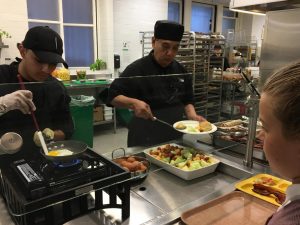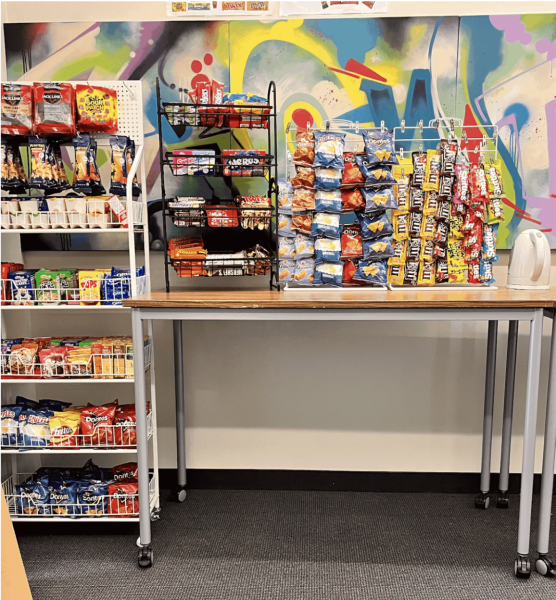Cafeteria plan provides variety
Pre-paid lunches allow for all-you-can-eat customizability
Senior Caroline Schulberg adds avocado chunks and other toppings to her salad from the cafeteria’s build-your-own salad bar. Students wear lanyards with their name and photo on them to show that they have paid for the meal plan.
September 27, 2018
With a daily menu featuring hot entree items, a build-your-own salad bar and panini-press, a new lunch system requires students to take part in a single-purchase or semester lunch plan replacing the pay-per-item method.
“We really wanted to improve the quality of the service for students and were not able to do that with the old retail model,” Chief Financial Officer Trisha Peterson said. “Sage was not able to plan the production of food each day.”
The new meal plan, which 56 percent of students in all four divisions have purchased, can be more cost efficient than previous years as the one-time payment covers multiple helpings of food items on the menu, according to Peterson.
“Last year, I wanted fruit a lot, but I did not want to spend hundreds of dollars trying to get fruit everyday,” senior Camilla Sigmund said. “What I like about this year is that I can get my meal and something on the side without being charged for multiple meals.”
Other students, such as junior Dena Silver, chose not to buy the food service because of its price. Silver says she either packs a lunch or goes off campus to Mayflower Market.
“I do not eat on campus often enough for it to be worth it,” Silver said. “I find that I can go to Mayflower and get a ton of snacks and drinks and something substantial to eat for around the same price.”
The meal plan is $1500 per year or $750 for the first semester and $850 for the second semester. The daily cost comes out to under $9 according to the Sage Team. A sandwich from Mayflower Market is $6.50 to $9 depending on options. Sides and chips are extra.
Each lunch is made from local fresh ingredients and goes through a revision process at the Sage headquarters to make sure each course has the right amount of nutrients that students require, according to Sage marketing. Students are served standard sized portions but can come back for multiple helpings.
“I like that [the Sage staff] serves the food to you because I think a big thing with nutritional health is portion size,” Gould said. “I think if they serve us, then they give us the healthy amount we should be eating for lunch. A lot of times people will just put too much food on their plate and end up wasting it.”
The wide variety of options including proteins, vegetables, fruits and gluten-free dishes allows students to try foods that they would not otherwise, according to Peterson.
“The Mediterranean and Greek food is by far my favorite,” Gould said. “The Greek salad, especially the cucumbers and spinach, tasted super fresh. Another time, the chicken was cooked perfectly — not dry — with really good seasoning.”
Many students say they wish the cafeteria offered a snack option between class periods or during free periods, according to Gould. When asked about the lack of non-lunchtime food service, the Sage team said they do not provide snacks.
“I really want the cafeteria to add a grab-and-go snack section because I get hungry during the day,” Gould said. “Also, freshmen are not allowed to leave campus during free periods to get food, so while other grades can sign out and quickly get a snack nearby, we cannot.”
Families can continue to opt-in to the daily lunch plan throughout the year, as well as purchase $20 breakfast punch cards.
“We want to encourage more people to join so that families who want to opt-in at any time can definitely do that,” Peterson said. “I think the quality has been amazing and a big improvement over the last few years.”













